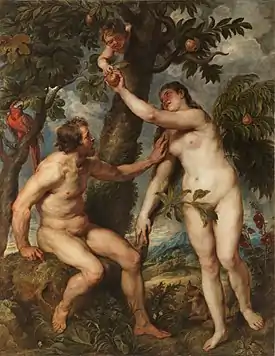The Fall of Man (Rubens)
The Fall of Man, Adam and Eve or Adam and Eve in the earthly paradise is a 1628–1629 painting by Rubens, now in the Prado in Madrid. Once attributed to the minor Dutch artist Karel van Mander, it is now recognised as a work by Rubens.

The Fall of Man (1628–1629) by Rubens
It is a copy of the painting of the same subject by Titian,[1] seen by Rubens during his 1628–1629 trip to Madrid for peace negotiations to end the Dutch Revolt. It reflects Raphael's influence on Titian and Jan Brueghel the Elder's influence on Rubens, who adds a parrot and changes Adam's posture, musculature, age and expression.[2]
 Version by Titian, c. 1550
Version by Titian, c. 1550
References
- "Titian catalogue entry". Museodelprado.es. 2009-09-15. Retrieved 2013-08-07.
- "Rubens catalogue entry". Museodelprado.es. 2009-09-15. Retrieved 2013-08-07.
| Source | |
|---|---|
| Offspring | |
| Related theology | |
| Other cultures | |
| Television |
|
| Film |
|
| Plays |
|
| Musicals |
|
| Compositions |
|
| Literature |
|
| Art |
|
| Songs |
|
| Albums |
|
| Geography | |
| Biology | |
| Story within a story | |
| Games |
|
| Other | |
| Authority control databases |
|---|
This article is issued from Wikipedia. The text is licensed under Creative Commons - Attribution - Sharealike. Additional terms may apply for the media files.